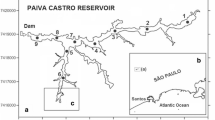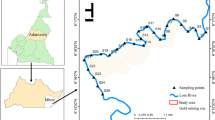Abstract
The environmental mobility and geochemical partitioning of ten metals were examined in sediments collected from the six locations around Lake Skadar in Montenegro. A three-step sequential extraction procedure was used to determine the distribution of the metals in various substrates of lacustrine sediments, and the concentrations were measured in the liquid extract by ICP-OES. The largest portion of the total amount of cadmium, strontium and manganese can be found in sediment bound to the hydrated iron and manganese oxides; cobalt, lead, copper and nickel in the oxidizable fraction and the highest portion of chromium, vanadium and zinc are in the residual fraction. The most mobilized and potentially mobile metals are strontium, cadmium and cobalt while the most immobilized metals are chromium, vanadium and zinc. Based on geochemical parameters, an assessment of sediment contamination by the investigated metals was performed and the results showed potential risks ranging from “no risk” to “low risk” to the environment.



Similar content being viewed by others
References
Abdel-Satar, A. M., & Goher, M. E. (2015). Heavy metals fractionation and risk assessment in surface sediments of Qarun and Wadi El-Rayan Lakes, Egypt. Environmental Monitoring and Assessment, 187 , 1–12.346
Abolfazl, N., Ahmad, I., & Abdul, R. I. (2010). Chemical speciation and contamination assessment of Zn and Cd by sequential extraction in surface sediment of Klang River, Malaysia. Microchemical Journal, 95, 285–292.
Adami, G., Barbieri, P., & Reisenhofer, E. (2000). An improved index for monitoring metal pollutants in surface sediments. Toxicological and Environmental Chemistry, 77, 189–197.
Amiard, J. C., Geffard, A., Amiard-Triquet, C., & Crouzet, C. (2007). Relationship between the lability of sediment-bound metals (Cd, Cu, Zn) and their bioaccumulation in benthic invertebrates. Estuarine, Coastal and Shelf Science, 72, 511–521.
Andersson, P. S., Wasseerburg, G. J., Ingri, J., & Stordal, M. C. (1994). Strontium, dissolved particulate loads in fresh and brackish waters: the Baltic Sea and Mississippi Delta. Earth and Planetary Science Letters, 124, 195–210.
Belazi, A. U., Davidson, C. M., Keating, G. E., Littlejohn, D., & McCartney, M. (1995). Determination and speciation of heavy metals in sediments from the Cumbrian coast, NW England, UK. Journal of Analytical Atomic Spectrometry, 10, 233–240.
Birch, G. (2003). In C. D. Woodcoffe & R. A. Furness (Eds.), A scheme for assessing human impacts on coastal aquatic environments using sediments (p. 14). Australia: Wollongong University Papers in Center for Maritime Policy.
Chakravarty, M., & Patgiri, A. D. (2009). Metal pollution assessment in sediments of the Dikrong River, N.E. India. Journal of Human Ecology, 27, 63–67.
Davidson, C. M., Duncan, A. L., Litteljohn, D., Ure, A. M., & Garden, L. M. (1998). A critical evaluation of the three stage BCR sequential extraction procedure to assess the potential mobility and toxicity of heavy metals in industrially-contaminated land. Analytica Chimica Acta, 363, 45–55.
Feng, H., Han, X., Zhang, W., & Yu, L. (2004). A preliminary study of heavy metal contamination in Yangtze River intertidal zone due to urbanization. Marine Pollution Bulletin, 49, 910–915.
Fernandez, E., Jimenez, R., Lallena, A. M., & Aguilar, J. (2004). Evaluation of the BCR sequential extraction procedure applied for two unpolluted Spanish soils. Environmental Pollution, 131, 355–364.
Gao, X., Chen, C. T. A., Wang, G., Xue, Q., Tang, C., & Chen, S. (2010). Environmental status of Daya Bay surface sediment inferred from a sequential extraction technique. Estuar Coast Shelf S, 86, 369–378.
Harikumar, P. S., & Jisha, T. S. (2010). Distribution pattern of trace metal pollutants in the sediments of an urban wetland in the southwest coast of India. International Journal of Engineering, Science and Technology, 2, 840–850.
Ip, C. C. M., Li, X. D., Zhang, G., Wai, O. W. H., & Li, Y. S. (2007). Trace metal distribution in sediments of the Pearl River estuary and the surrounding coastal area, South China. Environmental Pollution, 147, 311–323.
Jones, B., & Turki, A. (1997). Distribution and speciation of heavy metals in surficial sediments from the Tees estuary, north-east England. Marine Pollution Bulletin, 34, 768–779.
Jović, M., Stanković, A., Slavković-Beskoski, L., Tomić, I., Degetto, S., & Stanković, S. (2011). Mussels as a bioindicator of the environmental quality of the coastal water of the Boka Kotorska Bay (Montenegro). Journal of the Serbian Chemical Society, 76, 933–946.
Kastratović V, Đurović D, Krivokapić S, Mugoša B (2013) in Proceedings of 16th International Conference on Heavy Metals in the Environment. Rome, Italy, 33006 p. 1–4
Li, X. D., Shen, Z. G., Wai, O. W. H., & Li, Y. S. (2001). Chemical forms of Pb, Zn and Cu in the sediment profiles of the Pearl River estuary. Marine Pollution Bulletin, 42, 215–223.
Li, Q. S., ZF, W., Chu, B., Zhang, N., Cai, S. S., & Fang, J. H. (2007). Heavy metals in coastal wetland sediments of the Pearl River estuary, China. Environmental Pollution, 149, 158–164.
Maiz, I., Arambarri, I., Garcia, R., & Millan, E. (2000). Evaluation of heavy metal availability in polluted soils by two sequential extraction procedures using factor analysis. Environmental Pollution, 110, 3–9.
Marković, A. D., Đarmati, A. M., & Gržetić, A. I. (1996). Physico-chemical basis of environment protection, Book II. Sources of pollution, effects and protection (pp. 210–225) . Serbia: University of Belgrade.in Serbian
Martin, J. M., & Meybeck, M. (1979). Elemental mass balance of materials carried by major world rivers. Marine Chemistry, 7, 173–206.
Müller G (1979) Schwermetalle in den Sediment des Rheins. Veranderungen Seit 79:778–783
Muller, G. (1981). Die Schwermetallbelstung der sedimente des Neckars und seiner Nebenflusse: Eine Bestandsaufnahme. Chemiker-Zeitung, 105, 156–164.
Pakzad, H. R., Pasandi, M., Yeganeh, S., & Lahijani, H. (2016). Assessment of heavy metal enrichment in the offshore fine-grained sediments of the Caspian Sea. Environmental Monitoring and Assessment, 188, 303.
Pardo, R., Barrado, E., Castrillejo, Y., Velasco, M. A., & Vega, M. (1993). Study of the contents and speciation of heavy metals in river sediments by factor analysis. Analytical Letters, 26, 1719–1739.
Pardo, R., Barrado, E., Perez, L., & Vega, M. (1990). Determination and association of heavy metals in sediments of the Pisucraga river. Water Research, 24, 373–379.
Passos, E. A., Alves, J. P. H., Garcia, C. A. B., & Costa, A. C. S. (2011). Metal fractionation in sediments of the Sergipe River, northeast, Brazil. Journal of the Brazilian Chemical Society, 22, 828–835.
Pempkowiak, J., Sikora, A., & Biernacka, E. (1999). Speciation of heavy metals in marine sediments vs their bioaccumulation by mussels. Chemosphere, 39, 313–321.
Perin, G., Craboledda, L., Lucchese, M., Cirillo, R., Dotta, L., Zanetta, M. L., & Oro, A. A. (1985). Heavy metal speciation in the sediments of northern Adriatic Sea. A new approach for environmental toxicity determination. In T. D. Lakkas (Ed.), Heavy metals in the environment (Vol. 2). Edinburgh: CEP Consultants.
Petersen, W., Wallmann, K., Li, P. L., Schroeder, F., & Knauth, H. D. (1995). Exchange of trace elements of the sediment-water interface during early diagenesis processes. Marine and Freshwater Research, 46, 19–26.
Petrović, G. (1981). Chemichal investigations of water and sediments of Lake Skadar, the biota and limnology of Lake Skadar university of Michigan. Ann Arbor Michigan, U.S.A, 68–93.
Pueyo, M., Sastre, J., Hernandez, E., Vidal, M., Lopez-Sanchez, J. F., & Rauret, G. (2003). Prediction of trace element mobility in contaminated soils by sequential extraction. Journal of Environmental Quality, 32, 2054–2066.
Rath, P., Panda, U. C., Bhatta, D., & Sahoo, B. N. (2005). Environmental quantification of heavy metals in the sediments of the Brahmani and Nandira rivers, Orissa. Journal of the Geological Society of India, 65, 487–492.
Rauret, G., Lopez-Sanchez, J. F., Sahuquillo, A., Rubio, R., Davidson, C., Ure, A. M., & Quevauviller, P. J. (1999). Improvement of the BCR three step sequential extraction procedure prior to the certification of new sediment and soil reference materials. Journal of Environmental Monitoring, 1, 57–61.
Sáenz, V., Blasco, J., & Gómez-Parra, A. (2003). Speciation of heavy metals in recent sediments of three coastal ecosystems in the Gulf of Cádiz, southwest Iberian peninsula. Environmental Toxicology and Chemistry, 22(12), 2833–2839.
Simex, S. A., & Helz, G. R. (1981). Regional geochemistry of trace elements in Chesapeake Bay. Environmental Geology, 3, 315–323.
Taylor, S. R., & McLennan, S. M. (1985). The continental crust: its composition and evolution (p. 312). Carlton, England: Blackwell Scientific Publication.
Teng, Y., Yang, J., Sun, Z., Wang, J., Zuo, R., & Zheng, J. (2011). Environmental vanadium distribution, mobility and bioaccumulation in different land-use districts in Panzhihua region, SW China. Environmental Monitoring and Assessment, 176, 605–620.
Tessier, A., Campbell, P. G. C., & Bisson, M. (1979). Sequential extraction procedure for the speciation of particulate trace metals. Analytical Chemistry, 51, 844–851.
Tokalioğlu, S., Kartal, S., & Elcxi, L. (2000). Determination of heavy metals and their speciation in lake sediments by flame atomic absorption spectrometry after a four-stage sequential extraction procedure. Analytica Chimica Acta, 413, 33–40.
Tomlinson, D. C., Wilson, J. G., Harris, C. R., & Jeffery, D. W. (1980). Problems in the assessment of heavy metals levels in estuaries and the formation of a pollution index. Helgoland Marine Research, 33, 566–575.
Umoren, I. U., Udoh, A. P., & Udousoro, I. I. (2007). Concentration and chemical speciation for the determination of Cu, Zn, Ni, Pb and Cd from refuse dump soils using the optimized BCR sequential extraction procedure. The Environmentalist, 27, 241–252.
Ure, A. M. (1996). Single extraction schemes for soil analysis and related applications. Science of the Total Environment, 178, 3–10.
USEPA Method 3051a. Microwave assisted acid digestion of sediments, sludges, soils and oils, Revision 1 (2007)
Venkatramanan, S., Chung, S. Y., Ramkumar, T., & Selvam, S. (2015). Environmental monitoring and assessment of heavy metals in surface sediments at Coleroon River estuary in Tamil Nadu, India. Environmental Monitoring and Assessment, 187 , 1–16.505
Wang, S., Jia, Y., Wang, S., Wang, X., Wang, H., Zhao, Z., & Liu, B. (2010). Fractionation of heavy metals in shallow marine sediments from Jinzhou Bay, China. Journal of Environmental Sciences, 22, 23–31.
Xu, Y., & Marcantonio, F. (2004). Speciation of strontium in particulates and sediments from the Mississippi River mixing zone. Geochimica et Cosmochimica Acta, 68, 2649–2657.
Yobouet, Y. A., Adouby, K., Trokourey, A., & Yao, B. (2010). Cadmium, copper, lead and zinc speciation in contaminated soils. International Journal of Engineering, Science and Technology, 2, 802–812.
Yuan, C., Shi, J., He, B., Liu, J., Liang, L., & Jiang, G. (2004). Speciation of heavy metals in marine sediments from the East China Sea by ICP-MS with sequential extraction. Environment International, 30, 769–783.
Zakir, H. M., Shikazono, N., & Otomo, K. (2008). Geochemical distribution of trace metals assessment of anthropogenic pollution in sediments of old Nakagawa River, Tokyo, Japan. American Journal of Environmental Sciences, 4, 661–672.
Zakir, H. M., & Shikazono, N. (2011). Environmental mobility and geochemical partitioning of Fe, Mn, Co, Ni and Mo in sediments of an urban river. J Environ Chem Ecotoxicol, 3, 116–126.
Zhang, J., & Liu, C. L. (2002). Riverine composition and estuarine geochemistry of particulate metals in China-weathering features, anthropogenic impact and chemical fluxes. Estuar Coast Shelf S, 54, 1051–1070.
Author information
Authors and Affiliations
Corresponding author
Rights and permissions
About this article
Cite this article
Kastratović, V., Jaćimović, Ž., Bigović, M. et al. Environmental status and geochemical assessment sediments of Lake Skadar, Montenegro. Environ Monit Assess 188, 449 (2016). https://doi.org/10.1007/s10661-016-5459-0
Received:
Accepted:
Published:
DOI: https://doi.org/10.1007/s10661-016-5459-0




